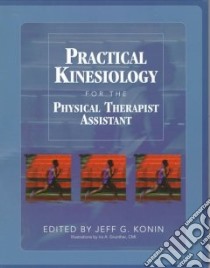Practical Kinesiology - 9781556422997
Un libro in lingua di Konin Jeff G. (EDT) Grunther Ira A. (ILT) edito da Slack Inc, 1999
- € 39.80
- Il prezzo è variabile in funzione del cambio della valuta d’origine
Practical Kinesiology for the Physical Therapist Assistant addresses the specific issues faced by the PTA student when studying the basics of human movement. By taking an introductory look at the foundation of biomechanics along with a clinical perspective of the application of skills, Jeff G. Konin has developed an outstanding text for the PTA classroom.
The responsibilities of the PTA have grown considerably. The goal of this book is to provide the PTA student with knowledge to enable him/her to recognize normal human movement and how interruptions to that normalcy can cause pathological conditions.
Initial chapters address terminology, biomechanical principles, joint structure and function, as well as muscle structure and function. An entire chapter is dedicated to providing valuable information on the principles of tissue repair. Subsequent chapters address individual body regions including: the shoulder, elbow, wrist and hand, spine and posture, the hip, knee, and ankle and foot. The final chapter discusses gait and how the PTA should approach understanding this complex topic in physical therapy. An appendix on muscles is included as well as an appendix for the student solving biomechanical equations of the trigonometric type.
Practical Kinesiology for the Physical Therapist Assistant is organized in a very clear and straightforward style and format. Each chapter follows a consistent, easy-to-use format, including learning objectives and end of chapter study questions. Precise illustrations throughout the book demonstrate concepts in the text.
Practical Kinesiology for the Physical Therapist Assistant Laboratory Manual (150 pp, Soft Cover, 1999, ISBN 1-55642-419-1, Order# 44191, $14.95) complements this outstanding textbook. Written specifically for the student, this Lab Manual contains practical laboratory objectives, anatomical reviews, definitions, diagrams to be labeled, discussion questions, and classroom activities. A variety of learning tools provide a creative, fun outlet for the student to retain the material included in the textbook.
Informazioni bibliografiche
- Titolo del Libro in lingua: Practical Kinesiology
- Lingua: English
- Autori : Konin Jeff G. (EDT) Grunther Ira A. (ILT)
- Editore: Slack Inc
- Collana: Slack Inc (Paperback)
- Data di Pubblicazione: 01 Gennaio '99
- Genere: MEDICAL
- Argomenti : Kinesiology Physical therapy assistants Allied Health Personnel
- Pagine: 212
- Dimensioni mm: 285 x 203 x 12
- ISBN-10: 1556422997
- EAN-13: 9781556422997


